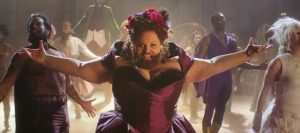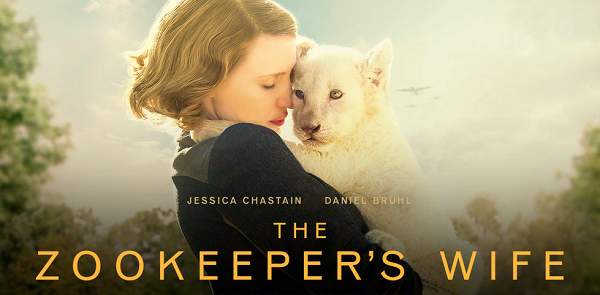The Overture
 A couple things happened in the past couple of years leading up to the release of The Greatest Showman. In 2016, one of the award show darlings was La La Land: a musical in a style we hadn’t seen in years. It called back to White Christmas, Holiday Inn, and Singin’ in the Rain. It caused critics and audience alike to wonder if this would harken in another golden era of musicals. True, we get Disney musicals and animated musical fare on a regular basis, but not the more theatrical, live-action spectacles of yesteryear.
A couple things happened in the past couple of years leading up to the release of The Greatest Showman. In 2016, one of the award show darlings was La La Land: a musical in a style we hadn’t seen in years. It called back to White Christmas, Holiday Inn, and Singin’ in the Rain. It caused critics and audience alike to wonder if this would harken in another golden era of musicals. True, we get Disney musicals and animated musical fare on a regular basis, but not the more theatrical, live-action spectacles of yesteryear.
I really liked a lot of what they did with La La Land, but I had two reservations: first, the main actors were just that, actors – they were out of their element when it came to the singing and dancing; and second, the tone was much more somber than the old musicals it was based on – those movies were meant to cheer people up during war times and depression in the economy. What better way to raise spirits than to show people bursting into song?
The second thing to happen leading up to The Greatest Showman was that, last year, the circus officially closed. Amid accusations of animal mistreatment, rising costs of production, and lowered ticket sales, they could no longer keep the show going. So it seems a fitting time to get the lyricists from La La Land back together and see if a musical based on P. T. Barnum’s life can’t build on both events.
The Opening Number
Full disclosure: I did not know what I was walking into when I went to the theatre with my wife. She liked the idea of a flashy circus movie with Hugh Jackman, and we had a day off, so we went. The music started playing, and then singing and dancing, and we realized we had stumbled into a musical.
 Two things immediately stood out to me in contrast to La La Land: First, The Greatest Showman was performed by dancers and singers who act, and it was a more modern musical than its predecessor. The first time I saw Hugh Jackman was in a rendition of Oklahoma, so it always makes sense to me to see him dance and sing; even if he is better known as our generation’s grizzled Wolverine. As the movie continued, I spotted another musical fellow – Zac Efron, whom you may remember started off in “High School Musical” and not the raunchy comedies he’s found himself sequestered to lately. Add to that Zendaya, from a Disney upbringing and a recent turn in Spiderman, doing all her own trapeze stunts; and you have a very well-performed score and choreography that hasn’t been seen in a while.
Two things immediately stood out to me in contrast to La La Land: First, The Greatest Showman was performed by dancers and singers who act, and it was a more modern musical than its predecessor. The first time I saw Hugh Jackman was in a rendition of Oklahoma, so it always makes sense to me to see him dance and sing; even if he is better known as our generation’s grizzled Wolverine. As the movie continued, I spotted another musical fellow – Zac Efron, whom you may remember started off in “High School Musical” and not the raunchy comedies he’s found himself sequestered to lately. Add to that Zendaya, from a Disney upbringing and a recent turn in Spiderman, doing all her own trapeze stunts; and you have a very well-performed score and choreography that hasn’t been seen in a while.
Second, the editing was spot-on to my tastes as well; there was just enough over-the-top showmanship to the visuals, but not at the expense of the scene. A rooftop dance with a moon that comes in big and fast like a stage backdrop; a slow motion moment to let the solo shine; a brief linger before the cut to admire the composition of elements set before you in a poignant moment. It felt like the moments Zack Snyder strives to achieve in his films, but set in a musical with a light hand. So, all in all, for a musical I was unaware I was walking into, it pleasantly surprised me in many ways. I would highly recommend it to all fans of cheery, feel-good musicals.
The First Act
Let it be known that you are not walking into a biographically accurate representation of the life and events of P. T. Barnum. Zac Efron and Zendaya, mentioned above, had fictional characters created for them to play, based on no actual people. There are definite similarities to P. T. and his life story, but it is a Hollywood co-opted version of his life.
 There is a class-clash, rags-to-riches story for our main protagonist that shouldn’t surprise many viewers, but the story also branches out to just about every character and brings out their struggles as well. The side-show performers who vacillate between feeling empowered and exploited; the son born into excess wanting to be his own person, but scared to leave the security his family’s money and good graces can afford him; the performer who excels in fame and fortune but will never be satisfied; and the woman who wants to love a man but feels her relationship will cost him too much. And although they may be nothing new to some, or not dwelt on long enough for others, I had a good time watching each number play out differently. And seeing how each reprisal added depth or nuance to each song to make it richer than the last time I heard it.
There is a class-clash, rags-to-riches story for our main protagonist that shouldn’t surprise many viewers, but the story also branches out to just about every character and brings out their struggles as well. The side-show performers who vacillate between feeling empowered and exploited; the son born into excess wanting to be his own person, but scared to leave the security his family’s money and good graces can afford him; the performer who excels in fame and fortune but will never be satisfied; and the woman who wants to love a man but feels her relationship will cost him too much. And although they may be nothing new to some, or not dwelt on long enough for others, I had a good time watching each number play out differently. And seeing how each reprisal added depth or nuance to each song to make it richer than the last time I heard it.
The Show-Stopping Number
 So far, I’ve more or less just doted on the performances and composition of the film, but the best/worst song has to be given to the Opera Singer character Jenny Lind that Barnum takes to America to go on tour. The song is a standout for sure: one of the sadder songs among many upbeat and encouraging arrangements, but also the only one that felt jarring. She is touted as a famous opera singer and so you might assume she would get an operatic song or something that alludes to that style at least, but we get another kind of “pop-y” song. It helps that the singer performing behind the actress does a good job, but it didn’t meet expectations. And then, the poor actress looks like she is trying to stand still to convey being an opera singer but moves her arms and breathes like someone who has never seen an opera singer perform. It brought to mind the inflatable men at car lots that are tethered to one spot at the base but keep flopping around with everything else they can.
So far, I’ve more or less just doted on the performances and composition of the film, but the best/worst song has to be given to the Opera Singer character Jenny Lind that Barnum takes to America to go on tour. The song is a standout for sure: one of the sadder songs among many upbeat and encouraging arrangements, but also the only one that felt jarring. She is touted as a famous opera singer and so you might assume she would get an operatic song or something that alludes to that style at least, but we get another kind of “pop-y” song. It helps that the singer performing behind the actress does a good job, but it didn’t meet expectations. And then, the poor actress looks like she is trying to stand still to convey being an opera singer but moves her arms and breathes like someone who has never seen an opera singer perform. It brought to mind the inflatable men at car lots that are tethered to one spot at the base but keep flopping around with everything else they can.
Curtain Call
Great, so I’ve given a long critique of the musical; but this is Redeeming Culture, not Rotten Tomatoes: we want to look at the biblical side of things. So let’s look at that a little bit, shall we?
 I mentioned the different struggles the cast of characters are dealing with. There is everything from classism to racism to prejudice of outward appearances. But the main theme that connects them all together under the big top is reaching past boundaries to celebrate our differences and learn to treat others with respect.
I mentioned the different struggles the cast of characters are dealing with. There is everything from classism to racism to prejudice of outward appearances. But the main theme that connects them all together under the big top is reaching past boundaries to celebrate our differences and learn to treat others with respect.
Jesus was a master at reaching past and ignoring boundaries. He spoke to the woman at the well; not only a woman who wasn’t a relative, but a Samaritan woman. And not only a Samaritan from a people group that did not get along with the Jews at all, but also a man-eater. So Jesus, a Jewish Rabbi, was speaking with a Samaritan woman he knew was with a man she wasn’t married to (and had gone through several others). What if the person you most looked up to spiritually was speaking in a coffee shop with a drug dealing pimp from a group of people known for having lots of STD’s? That’s a lot of boundaries to cross publicly in one conversation, but Jesus did it.
And he did it in a way that didn’t gloss over or ignore her situation and what she needed to change, but he didn’t ridicule her or treat her any less human than his own disciples. That’s a big pill to swallow, especially when our lives can be insulated so easily. There are seasons where we may go long stretches of time without ever even coming across a boundary, much less having a regular opportunity to cross one. In the movie, a critical writer of Barnum’s show encourages him, at P. T.’s lowest point, that some might even have called his circus a “celebration of humanity,” having so many different types of people on one stage.
I would encourage all of us to strive for our churches and Bible studies to look like that: a celebration of humanity where boundaries are crossed to treat people like fellow humans; who have pasts and presents to work on that aren’t glossed over, but aren’t ridiculed either.
Let our church be a celebration of humanity; not because humanity is great, but because the God who unites us is.

Thanks for reading Redeeming Culture!



1 comment